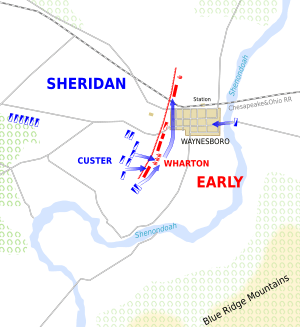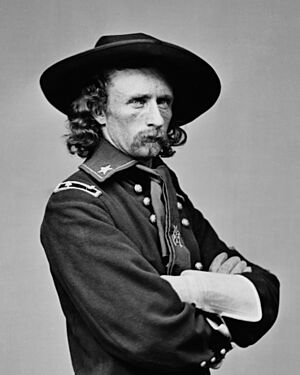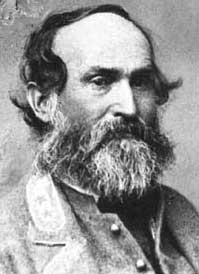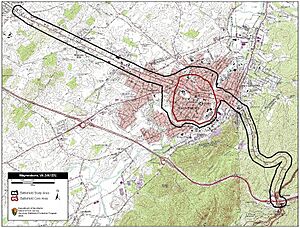Battle of Waynesboro, Virginia facts for kids
Quick facts for kids Battle of Waynesboro |
|||||||
|---|---|---|---|---|---|---|---|
| Part of the American Civil War | |||||||
|
|||||||
| Belligerents | |||||||
| Commanders and leaders | |||||||
| Philip Sheridan George Armstrong Custer |
Jubal Early | ||||||
| Strength | |||||||
| 2,500 | 1,600 | ||||||
| Casualties and losses | |||||||
| 9 | 1,500+ | ||||||
The Battle of Waynesboro was a big fight during the American Civil War. It happened on March 2, 1865, in Waynesboro, Virginia. This battle was a clear win for George Armstrong Custer and his Union soldiers. It was the last major battle for Confederate General Jubal Early, whose army was defeated.
Contents
Background to the Battle
In late February 1865, Union General Philip Sheridan led his cavalry (soldiers on horseback) from Winchester, Virginia. They rode through the Shenandoah Valley towards Staunton. His plan was to go south and meet up with General William T. Sherman's army.
On February 28, General George Armstrong Custer's Union soldiers met about 300 Confederate cavalrymen. These Confederates were led by General Thomas Rosser. Rosser tried to slow down the Union forces by setting a long covered bridge on fire. Custer quickly sent some of his soldiers to swim across the river. They attacked Rosser's soldiers from the side. Other Union soldiers put out the fire on the bridge. Custer's quick actions drove off the Confederates.
The Union forces then rode to Staunton, where they met the rest of Sheridan's army. General Sheridan decided to change his plans. Instead of going straight to Sherman, he wanted to defeat General Early's small Confederate force. He saw Early's army as a threat behind him.
On March 2, Custer's men headed towards Early's army in Waynesboro. Their orders were to find out where the enemy was and how strong they were. They also needed to destroy a railroad bridge. Heavy rain and sleet had made the roads very muddy. This made their march very slow and difficult.
Just six miles from Waynesboro, Custer's soldiers pushed back some Confederate guards. When they reached Waynesboro, Custer found Early's army ready for battle. They were dug in behind strong earthworks (dirt walls built for defense).
Who Fought in the Battle?
This section tells you about the main leaders and how many soldiers each side had.
Union Forces and Leaders
General Philip H. Sheridan was the overall leader for the Union in the Valley. However, he arrived after the battle was over. General George A. Custer was the main Union commander on the battlefield. He led the Third Cavalry Division.
Custer's division included three brigades (smaller groups of soldiers). These were led by Colonel Alexander Cummings McWhorter Pennington, Colonel William Wells, and Colonel Henry Capehart. They also had some artillery (cannons). Custer had about 2,500 soldiers in total.
Confederate Forces and Leaders
General Jubal A. Early commanded what was left of the Army of the Valley. By this time, his army was much smaller. It had only one infantry division (foot soldiers), three artillery batteries, and a very small group of cavalry.
The infantry division was led by General Gabriel C. Wharton. It had two small brigades. Colonel William Nelson commanded the Confederate artillery. General Early had sent most of his cavalry to other parts of the Valley. So, he had very few cavalry soldiers left for this battle.
Historians have different ideas about how many soldiers Early had. Early himself said he had "not more than 1,000 muskets" and six cannons. Union forces claimed they captured between 1,500 and 1,800 men. They also said they captured 11 to 14 cannons. Most historians believe Early had between 1,000 and 1,200 men. He also had 6 to 14 cannons.
The Battle Begins
General Early placed his soldiers on a low ridge (a long, narrow hill) west of Waynesboro. Earthworks protected the front of his position. He put three cannons on his far right side. An infantry brigade was placed near them. In the center, he had his small cavalry force and another infantry group. To their left, he placed more cannons. On his far left, he put his other infantry brigade.
However, Early made a mistake. He left his left side open. He thought a thick forest would stop any Union attack from that direction. Another problem was that his soldiers had only two ways to escape across the South River. There was a railroad bridge and a small footbridge. The river was swollen from the rain. Early later said he planned to retreat that night. He wanted darkness to hide his escape. He also claimed he needed to move supplies and cannons to safety.
Around 2:00 pm, Custer's men arrived outside Waynesboro. An artillery duel (a fight between cannons) began. Custer sent Colonel William Wells' brigade forward to check the enemy's position. They quickly found that the Confederates were well-defended.
But soon after, Custer learned about the open space on the Confederate left side. He realized he could attack from the side instead of head-on. This would save his soldiers from many injuries. Custer ordered Colonel Alexander Cummings McWhorter Pennington to take three regiments (groups of soldiers). They were to attack the Confederate left side.
Custer then told Wells to make a fake attack on the Confederate center. This was to distract the enemy from Pennington's flanking move. Colonel Henry Capehart's brigade was kept ready as a backup.
The Attack and Rout
At 3:30 pm, the signal to attack was given. Custer's cannons started firing, drawing the Confederates' attention. Minutes later, Pennington's soldiers rushed out of the woods. They were dismounted (off their horses) and carried special rifles. They surprised the Confederates and quickly attacked their left side.
Just as the Confederates tried to turn and face this new threat, Wells' and Capehart's brigades charged the Confederate center. In just a few minutes, Early's army was in a complete panic. One historian said the Confederates only fired one volley (a single round of shots).
Jedediah Hotchkiss, a mapmaker for General Early, called the defeat "one of the most terrible panics and stampedes I have ever seen." The only escape routes over the South River quickly became jammed with fleeing soldiers and equipment. Hundreds of Confederates were captured as they tried to cross the river.
Confederate Colonel William Harman was killed during the battle. He was surrounded by five Union soldiers but refused to surrender. Dr. Hunter McGuire, from Early's staff, was captured. He was trying to jump his horse over a fence when he fell. A Union soldier was about to shoot him. But the doctor gave a special sign, which a Union officer recognized. The officer stepped in and saved the doctor, though he was taken prisoner.
General Early and some of his staff managed to escape. But his entire army was either captured or scattered. They never again formed an effective fighting force for the rest of the war.
What Happened Next?
Custer's soldiers chased the defeated Confederates for about 12 miles. They stopped when it got dark. Union officers claimed they captured between 1,000 and 1,800 men. They also said they took 11 to 14 cannons, many wagons, and 16 flags. Even though General Early disagreed with these numbers, evidence suggests the Union claims were very close to the truth.
No matter the exact numbers, everyone agrees that Early lost all his cannons, wagons, and ambulances. His infantry (foot soldiers) were too broken to fight effectively again. Custer reported that his own losses were very small: only 9 men killed or wounded.
After the battle, General Sheridan crossed the Blue Ridge Mountains to Charlottesville. He then raided south, destroying parts of the James River Canal. On March 26, he joined forces with the main Union army near Petersburg. This was for the start of the Appomattox Campaign, which ended the war. General Early never received another command for the rest of the war.
Two Union soldiers received the Medal of Honor for their bravery in this battle. Captain Christopher C. Bruton received it for capturing Early's headquarters flag. Second Lieutenant Andrew Kuder also received the Medal of Honor for his heroism and capturing a flag.





